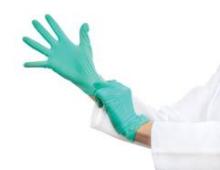SAN FRANCISCO – Universal glove and gown precautions in the intensive care unit setting reduced acquisition of methicillin-resistant Staphylococcus aureus by nearly 40% in a cluster randomized trial.
This "very meaningful reduction" was significantly greater than the 15% reduction in the relative risk of acquiring MRSA in a control group that received usual care, Dr. Anthony D. Harris reported at IDWeek 2013, an annual scientific meeting on infectious diseases.
Although the primary composite outcome of MRSA or vancomycin-resistant enterococcus acquisition was not met in the study (the Benefits of Universal Glove and Gown, or BUGG study), this was because no difference was seen in the rate of VRE acquisition in the intervention and control groups – possibly because of variations in the biology of MRSA and VRE, explained Dr. Harris of the University of Maryland, Baltimore.
Overall, the relative risk reduction from baseline was 20.8% in the intervention group, compared with 14.4% for the composite outcome in the control group, but the relative risk reduction for MRSA was 40.2% vs. 15.0%, and for VRE it was 10.5% vs. 17.3% in the groups, respectively, Dr. Harris said.
Furthermore, no adverse events associated with universal glove and gown use occurred, and the precautions were associated with an increase in hand hygiene compliance (78.9% vs. 62.9% in the intervention and control groups, respectively).
The findings were reported during a "featured abstract" presentation at the combined annual meetings of the Infectious Diseases Society of America, the Society for Healthcare Epidemiology of America, the HIV Medicine Association, and the Pediatric Infectious Diseases Society.
They were published simultaneously online Oct. 4 in JAMA (JAMA 2013 Oct. 4 [doi: 10.1001/jama.2013.277815]).
A total of 26,180 patients from 20 medical and surgical ICUs and 20 U.S. hospitals were included in the 9-month study, which was conducted between Jan. 4, 2012, and Oct. 4, 2012, and a total of 92,241 swabs were collected on admission and discharge to test for the primary outcome. In the intervention groups, health care workers were required to wear gloves and gown for all patient contact. Usual care was provided in the control arm.
Prior smaller studies showed that universal glove and gown precautions in the ICU setting could lead to decreased antibiotic resistant bacterial transmission, but numerous studies have also suggested that such precautions might have certain adverse events, Dr. Harris said.
"What we did find consistent with the literature is that health care workers seem to go into rooms less often when patients are on contact precautions ... you see about 1 visit less per hour in the intervention arm than in the control arm," he said, noting that visits dropped from about 5 to 4 per hour.
However, this did not translate to an increase in adverse events.
"Basically, we found no difference in the adverse event rate," he added, noting that, in fact, the trend was toward an increased adverse event rate in the control group (74.4 vs. 58.7 events per 1,000 patient-days in the control vs. intervention group, respectively).
While the findings are noteworthy given that antibiotic resistance is associated with considerable morbidity, mortality, and cost, and that MRSA is a primary cause of health care–associated infections that are linked to poor outcomes, they require replication before definitive conclusions can be reached, Dr. Harris said.
This study was supported by grants from the Agency for Healthcare Research and Quality and the National Institutes of Health. Dr. Harris reported serving as a consultant for Premier, Cubist, and Sanogiene. He is an editor for UpToDate Online. Several other authors reported financial ties to drug and medical device companies. Detailed disclosures are provided with the full text of the JAMA article.


